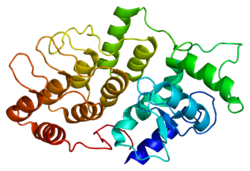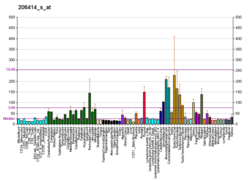Arf-GAP with SH3 domain, ANK repeat and PH domain-containing protein 2 is a protein that in humans is encoded by the ASAP2 gene .[5] [6] [7]
This gene encodes a multidomain protein containing an N-terminal alpha-helical region with a coiled-coil motif, followed by a pleckstrin homology (PH) domain, an Arf-GAP domain, an ankyrin homology region, a proline-rich region, and a C-terminal Src homology 3 (SH3) domain. The protein localizes in the Golgi apparatus and at the plasma membrane, where it colocalizes with protein tyrosine kinase 2-beta (PYK2). The encoded protein forms a stable complex with PYK2 in vivo. This interaction appears to be mediated by binding of its SH3 domain to the C-terminal proline-rich domain of PYK2. The encoded protein is tyrosine phosphorylated by activated PYK2. In vitro it shows strong GTPase-activating protein (GAP) activity towards the small GTPases ADP-ribosylation factor (ARF) 1 and ARF5 and weak activity towards ARF6. The encoded protein is believed to function as an ARF GAP that controls ARF-mediated vesicle budding when recruited to Golgi membranes. In addition, it functions as a substrate and downstream target for PYK2 and SRC, a pathway that may be involved in the regulation of vesicular transport.[7]
Interactions
edit
References
edit
^ a b c GRCh38: Ensembl release 89: ENSG00000151693 – Ensembl , May 2017^ a b c GRCm38: Ensembl release 89: ENSMUSG00000052632 – Ensembl , May 2017^ "Human PubMed Reference:" . National Center for Biotechnology Information, U.S. National Library of Medicine .^ "Mouse PubMed Reference:" . National Center for Biotechnology Information, U.S. National Library of Medicine .^ Andreev J, Simon JP, Sabatini DD, Kam J, Plowman G, Randazzo PA, Schlessinger J (Mar 1999). "Identification of a New Pyk2 Target Protein with Arf-GAP Activity" . Mol Cell Biol . 19 (3): 2338–50. doi :10.1128/MCB.19.3.2338 . PMC 84026 PMID 10022920 . ^ Ishikawa K, Nagase T, Nakajima D, Seki N, Ohira M, Miyajima N, Tanaka A, Kotani H, Nomura N, Ohara O (Feb 1998). "Prediction of the coding sequences of unidentified human genes. VIII. 78 new cDNA clones from brain which code for large proteins in vitro" . DNA Res . 4 (5): 307–13. doi :10.1093/dnares/4.5.307 PMID 9455477 . ^ a b "Entrez Gene: DDEF2 development and differentiation enhancing factor 2" .^ Andreev, J; Simon J P; Sabatini D D; Kam J; Plowman G; Randazzo P A; Schlessinger J (Mar 1999). "Identification of a New Pyk2 Target Protein with Arf-GAP Activity" . Mol. Cell. Biol . 19 (3): 2338–50. doi :10.1128/MCB.19.3.2338 . ISSN 0270-7306 . PMC 84026 PMID 10022920 .
Further reading
edit
Brown MT, Andrade J, Radhakrishna H, et al. (1998). "ASAP1, a Phospholipid-Dependent Arf GTPase-Activating Protein That Associates with and Is Phosphorylated by Src" . Mol. Cell. Biol . 18 (12): 7038–51. doi :10.1128/MCB.18.12.7038 . PMC 109286 PMID 9819391 . Kondo A, Hashimoto S, Yano H, et al. (2000). "A New Paxillin-binding Protein, PAG3/Papα/KIAA0400, Bearing an ADP-Ribosylation Factor GTPase-activating Protein Activity, Is Involved in Paxillin Recruitment to Focal Adhesions and Cell Migration" . Mol. Biol. Cell . 11 (4): 1315–27. doi :10.1091/mbc.11.4.1315 . PMC 14849 PMID 10749932 . Uchida H, Kondo A, Yoshimura Y, et al. (2001). "Pag3/Papα/Kiaa0400, a Gtpase-Activating Protein for Adp-Ribosylation Factor (Arf), Regulates Arf6 in Fcγ Receptor–Mediated Phagocytosis of Macrophages" . J. Exp. Med . 193 (8): 955–66. doi :10.1084/jem.193.8.955 . PMC 2193405 PMID 11304556 . Kim H, Lee Y (2002). "Interaction of poly(A) polymerase with the 25-kDa subunit of cleavage factor I". Biochem. Biophys. Res. Commun . 289 (2): 513–8. doi :10.1006/bbrc.2001.5992 . PMID 11716503 . Oshiro T, Koyama S, Sugiyama S, et al. (2002). "Interaction of POB1, a downstream molecule of small G protein Ral, with PAG2, a paxillin-binding protein, is involved in cell migration" . J. Biol. Chem . 277 (41): 38618–26. doi :10.1074/jbc.M203453200 PMID 12149250 . Strausberg RL, Feingold EA, Grouse LH, et al. (2003). "Generation and initial analysis of more than 15,000 full-length human and mouse cDNA sequences" . Proc. Natl. Acad. Sci. U.S.A . 99 (26): 16899–903. Bibcode :2002PNAS...9916899M . doi :10.1073/pnas.242603899 PMC 139241 PMID 12477932 . Ota T, Suzuki Y, Nishikawa T, et al. (2004). "Complete sequencing and characterization of 21,243 full-length human cDNAs" . Nat. Genet . 36 (1): 40–5. doi :10.1038/ng1285 PMID 14702039 . Hashimoto S, Hashimoto A, Yamada A, et al. (2004). "A novel mode of action of an ArfGAP, AMAP2/PAG3/Papa lpha, in Arf6 function" . J. Biol. Chem . 279 (36): 37677–84. doi :10.1074/jbc.M404196200 PMID 15231847 . Kojima C, Hashimoto A, Yabuta I, et al. (2005). "Regulation of Bin1 SH3 domain binding by phosphoinositides" . EMBO J . 23 (22): 4413–22. doi :10.1038/sj.emboj.7600442 . PMC 526460 PMID 15483625 . Gerhard DS, Wagner L, Feingold EA, et al. (2004). "The Status, Quality, and Expansion of the NIH Full-Length cDNA Project: The Mammalian Gene Collection (MGC)" . Genome Res . 14 (10B): 2121–7. doi :10.1101/gr.2596504 . PMC 528928 PMID 15489334 . Onodera Y, Hashimoto S, Hashimoto A, et al. (2005). "Expression of AMAP1, an ArfGAP, provides novel targets to inhibit breast cancer invasive activities" . EMBO J . 24 (5): 963–73. doi :10.1038/sj.emboj.7600588 . PMC 554134 PMID 15719014 . Olsen JV, Blagoev B, Gnad F, et al. (2006). "Global, in vivo, and site-specific phosphorylation dynamics in signaling networks" . Cell . 127 (3): 635–48. doi :10.1016/j.cell.2006.09.026 PMID 17081983 . S2CID 7827573 . Ewing RM, Chu P, Elisma F, et al. (2007). "Large-scale mapping of human protein–protein interactions by mass spectrometry" . Mol. Syst. Biol . 3 (1): 89. doi :10.1038/msb4100134 . PMC 1847948 PMID 17353931 .





